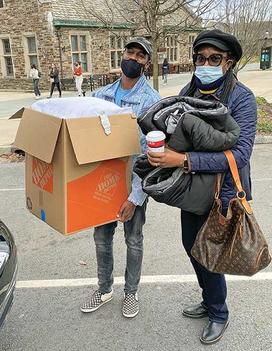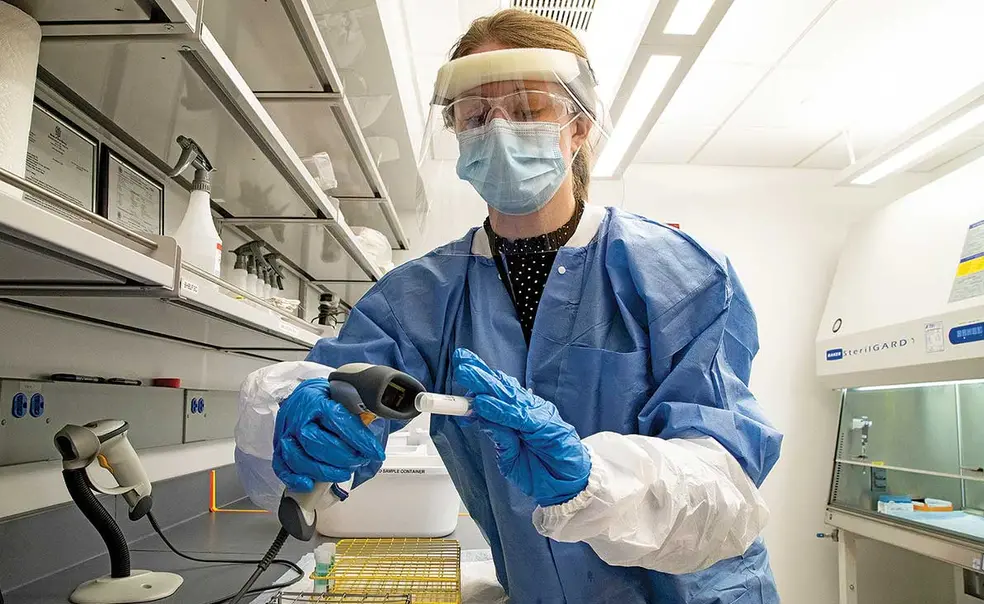Testing and Tracing Ramp Up As Thousands of Students Return
‘It takes a village,’ said Dan Notterman, administrative director of the University’s COVID-19 testing laboratory
Princeton undergraduate students who opted to return to campus for the spring semester arrived Jan. 16–24. Upon arrival, each student completed a saliva test for COVID-19 and quarantined in their room for one week, in preparation for the Feb. 1 start of classes.
Of the 4,700 currently enrolled undergraduates, about 2,900 are in University housing and between 700 and 800 will be living in the surrounding area, with access to campus, according to University spokesman Michael Hotchkiss. All students signed a social contract committing to various practices including social distancing, participating in weekly testing, and monitoring their health daily through the University’s symptom tracker.
“It takes a village,” said Dan Notterman, a professor and medical doctor who serves as the administrative director of the University’s COVID-19 testing laboratory, referring to the planning undertaken across the University to prepare for the spring semester.
In the fall, the University established its own testing lab in the Department of Molecular Biology. A couple of thousand saliva tests were done each week (separate from symptomatic testing) for the students and staff who were on campus. For the spring semester, testing in the lab was to be accelerated to support 15,000 samples each week.
“That involves pooling — mixing several samples together, testing one pool, and then if there’s a positive in the pool we retest all five,” said Notterman. “Since most pools will be negative, that gives us the ability to increase our testing capacity.”
Samples are spit into a tube that has a liquid that both inactivates the virus as well as preserves the genome of the virus. Individuals register their samples by scanning a bar code with their mobile devices. Samples deposited around campus are collected at least twice a day. The lab machine used for testing analyzes the samples to find three genes that are present in the virus. Samples containing two or three genes tested for are presumed positive. All positive results are reviewed by a board-certified physician before an individual is contacted with the results.
While most classes will remain virtual, some professors will incorporate in-person components.
As the testing laboratory prepared for the spring semester, Notterman said the value of testing was the biggest lesson he learned from the experience in the fall. “The more you test, the more disease you catch, and the less you have spread,” he said.
In combination with testing, contact tracing is another important piece of the formula to help keep the Princeton community safe, said Irini Daskalaki of University Health Services (UHS), lead physician for Princeton’s COVID-19-response program. The University and municipality of Princeton have partnered to develop policies and protocols for the contact-tracing process.
Daskalaki noted that confidentiality is key, so tracers do not report who tested positive when talking to those who had contact with them. This can be very frustrating for the people receiving the news, she said. To combat any reluctance to participate fully and honestly, tracers will not report students if they discover they have violated COVID policies.
Students living on campus who test positive will be moved to a dorm used for isolation. Dining services will deliver meals to those students throughout the isolation period.
“Contact tracing by itself, it is imperfect,” Daskalaki said. Since it relies on memory, it’s natural for individuals to forget details, which means the tracers will miss contacts.

Safety measures in dining halls include plexiglass, social-distance markers on the floor, circulation paths showing where individuals should enter and exit, and sensors at entrances so officials can keep track of the density.
“Our team is ready,” said Smitha Haneef, assistant vice president of campus dining. “Our team is excited to have our students back on campus. It’s going to be a learning curve for all of us, but we’re feeling confident and as prepared as we can for the spring.”
While most classes will remain virtual, some professors will teach in person. According to Hotchkiss, several dozen undergraduate and graduate courses will include in-person components. President Eisgruber ’83 is scheduled to teach one, a freshman seminar on “Free Speech in Law, Ethics, and Politics.”
In the fall, David Miller, lecturer and director of the Faith and Work Initiative, canceled his signature course, “Business Ethics: Succeeding Without Selling Your Soul,” because he was concerned its highly interactive nature wouldn’t work online. While most of his classes will be virtual for the spring semester, he planned to hold the opening class and final session in person (limit 50 people) in McCosh 50, in hopes of establishing some face-to-face connection.
“None of us want to be doing it this way,” Miller said. “We have to be candid. It’s far from ideal, but you know I sit in the Keller Center for Innovation — and so how do we innovate? How do we make the best of something? We will survive this and eventually be back, but maybe there are some silver linings we can learn from this.”












No responses yet